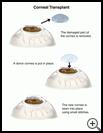
Corneal Transplant
________________________________________________________________________
KEY POINTS
- A corneal transplant is a procedure in which part or all of a cloudy, scarred, or damaged cornea is removed and replaced with a donated cornea. The cornea is the clear outer layer on the front of your eye. The surgery is done to improve your vision.
- Ask your provider how long it will take to recover and how to take care of yourself at home.
- Make sure you know what symptoms or problems you should watch for and what to do if you have them.
________________________________________________________________________
What is a corneal transplant?
A corneal transplant is a procedure in which part or all of a cloudy, scarred, or damaged cornea is removed and replaced with a donated cornea. The cornea is the clear outer layer on the front of your eye.
Corneas for transplant come from people who donated their corneas when they died. An eye bank examines, protects, and stores the donated corneas. Before a donated cornea is used, it is tested to make sure that it is healthy.
When is it used?
The surgery is done to improve your vision. Corneal problems that cause decreased vision include:
- Eye diseases that started at birth
- Fuchs corneal dystrophy, which is a common condition that can run in families and causes swelling and clouding of the cornea that gets worse with age
- Keratoconus, which is a condition that causes the cornea to bulge into a cone shape that causes vision problems
- Previous operations on your eye, such as cataract surgery
- Scars from eye injuries or infections
How do I prepare for this procedure?
- Plan for your care and find someone to give you a ride home after the procedure.
- You may or may not need to take your regular medicines the day of the procedure. Tell your healthcare provider about all medicines and supplements that you take. Some products may increase your risk of side effects. Ask your healthcare provider if you need to avoid taking any medicine or supplements before the procedure.
- Your healthcare provider will tell you when to stop eating and drinking before the procedure. This helps to keep you from vomiting during the procedure.
- Do not wear eye makeup on the day of the surgery.
- Follow any other instructions your healthcare provider gives you.
- Ask any questions you have before the procedure. You should understand what your healthcare provider is going to do.
What happens during the procedure?
Sometimes a general anesthetic is used. General anesthesia relaxes your muscles and you will be asleep. Most of the time a local anesthetic and sedative are used instead. The local anesthetic numbs your eye and the sedative relaxes you.
During the procedure, either the damaged part of the cornea is removed, or the entire cornea is removed and replaced with the donor cornea. The new cornea may be sewn into place using small stitches that can be removed later. If your eye has a cataract, the cataract may be able to be removed at the same time.
Your eye care provider will put a patch over your eye. You will be able to go home when you are fully awake, 1 to 2 hours after the surgery.
What happens after the procedure?
There is usually very little discomfort after surgery. You may feel like you have something in your eye for a few days. You will use eye drops several times a day for a long time. They help prevent infection and rejection of the new cornea.
It takes time for good vision to return after this surgery. You will probably get new glasses or contact lenses 4 to 12 months after surgery.
Ask your healthcare provider:
- How and when you will get your test results
- How long it will take to recover
- If there are activities you should avoid, including how much weight you can lift and when you can return to your normal activities
- How to take care of yourself at home
- What symptoms or problems you should watch for and what to do if you have them
Make sure you know when you should come back for a checkup. Keep all appointments for provider visits or tests.
What are the risks of surgery?
Every procedure or treatment has risks. Some possible risks of this procedure include:
- You may have problems with anesthesia.
- You may have a serious infection or bleeding that can permanently damage your eyes.
- You may have blurry vision caused by an uneven cornea. This may be corrected with glasses, contact lenses, or surgery.
- You may have graft failure, which means that the transplanted cornea becomes too cloudy to allow good vision. This may happen, for example, because the body rejects the new cornea. If this happens, you may need another surgery. The risk of graft failure is increased by uncontrolled high pressure in your eyes, a history of inflammation in the cornea, or abnormal blood vessels in the cornea.
If your eye is injured after your corneal transplant, it can cause more severe damage than injury to an eye without a transplant.
Ask your healthcare provider how these risks apply to you. Be sure to discuss any other questions or concerns that you may have.

